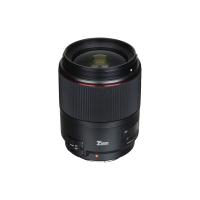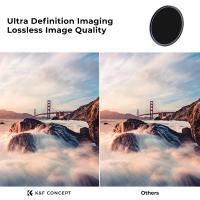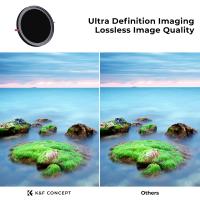How Much Can Light Microscopes Magnify ?
Light microscopes can typically magnify objects up to around 1000 times their original size. However, the actual magnification power depends on various factors, including the quality of the microscope's lenses and the numerical aperture. The maximum magnification is usually achieved by using oil immersion lenses, which require a drop of oil to be placed between the lens and the specimen. It is important to note that while light microscopes can provide high magnification, they have limitations in resolving fine details due to the wavelength of visible light. For higher magnification and resolution, electron microscopes are used.
1、 Resolution: The ability to distinguish two closely spaced objects.
Light microscopes are widely used in various scientific fields to observe and study microscopic objects. They utilize visible light to magnify and visualize specimens. The magnification power of a light microscope refers to how much larger an object appears compared to its actual size. However, it is important to note that the magnification of a light microscope is limited.
Light microscopes can typically magnify objects up to around 1000 times their original size. This is achieved by using a combination of objective lenses and eyepieces. The objective lens is responsible for the initial magnification, while the eyepiece further magnifies the image for the observer. The total magnification is calculated by multiplying the magnification of the objective lens by the magnification of the eyepiece.
On the other hand, resolution refers to the ability of a microscope to distinguish two closely spaced objects as separate entities. It is a measure of the microscope's ability to provide clear and detailed images. The resolution of a light microscope is limited by the wavelength of visible light, which ranges from approximately 400 to 700 nanometers.
According to the Abbe diffraction limit, the maximum resolution of a light microscope is around 200-300 nanometers. This means that two objects closer than this distance will appear as a single blurred image. However, advancements in microscopy techniques and technologies have allowed scientists to achieve higher resolution using light microscopes.
One such technique is called super-resolution microscopy, which surpasses the diffraction limit and enables the visualization of structures as small as a few nanometers. Techniques like stimulated emission depletion (STED) microscopy and structured illumination microscopy (SIM) have been developed to enhance the resolution of light microscopes. These techniques involve manipulating the light and using fluorescent dyes to improve the clarity and resolution of the images.
In conclusion, light microscopes can magnify objects up to around 1000 times their original size. However, their resolution is limited to approximately 200-300 nanometers due to the wavelength of visible light. Nevertheless, advancements in super-resolution microscopy techniques have pushed the boundaries of resolution, allowing scientists to observe and distinguish objects at a much smaller scale.

2、 Magnification: The degree to which an object is enlarged.
Light microscopes are widely used in various scientific fields to observe and study microscopic objects. Magnification is a crucial aspect of these microscopes as it determines the level of detail that can be observed.
Magnification refers to the degree to which an object is enlarged when viewed through a microscope. In the case of light microscopes, the maximum magnification achievable is typically around 1000x to 2000x. This means that the object being observed appears up to 2000 times larger than its actual size. However, it is important to note that the practical limit of magnification is often lower due to various factors such as the quality of the microscope's optics and the resolution of the human eye.
The magnification of light microscopes is achieved through a combination of objective lenses and eyepieces. The objective lens is responsible for gathering light and forming the initial magnified image, while the eyepiece further magnifies this image for the viewer. By using different combinations of objective lenses and eyepieces, various levels of magnification can be achieved.
It is worth mentioning that the maximum useful magnification of a light microscope is often limited by the resolving power of the microscope. Resolving power refers to the ability of the microscope to distinguish between two closely spaced objects as separate entities. Beyond a certain magnification, the resolution of the microscope becomes limited, and the image appears blurry or distorted.
In recent years, advancements in technology have led to the development of more powerful microscopes, such as electron microscopes, which can achieve much higher magnifications. Electron microscopes use a beam of electrons instead of light, allowing for magnifications up to several million times. These microscopes have revolutionized the field of microscopy and have enabled scientists to observe and study objects at an unprecedented level of detail.
In conclusion, light microscopes can typically achieve magnifications of around 1000x to 2000x, although the practical limit may be lower due to various factors. The resolving power of the microscope also plays a crucial role in determining the maximum useful magnification. For higher magnifications, electron microscopes are the preferred choice in modern microscopy.

3、 Numerical Aperture: Determines the resolving power of a microscope.
Light microscopes are widely used in various scientific fields to observe and study microscopic objects. One important aspect of a light microscope's performance is its ability to magnify the specimen being observed. However, the maximum magnification achievable by a light microscope is limited by several factors, with the most significant being the numerical aperture (NA) of the microscope's objective lens.
Numerical aperture refers to the ability of an objective lens to gather and focus light from the specimen onto the image plane. It is determined by the lens design and the refractive index of the medium between the lens and the specimen. The higher the numerical aperture, the greater the resolving power of the microscope, allowing for finer details to be observed.
In general, light microscopes can achieve magnifications up to around 1000x. However, it is important to note that the maximum useful magnification is often lower due to factors such as lens aberrations and the limitations of the human eye. At higher magnifications, the image quality may deteriorate, resulting in a loss of clarity and resolution.
It is worth mentioning that recent advancements in microscope technology, such as the development of high numerical aperture lenses and the incorporation of digital imaging systems, have pushed the limits of light microscopy. These advancements have allowed for improved resolution and the ability to observe smaller structures with greater detail.
In conclusion, the maximum magnification achievable by light microscopes is primarily determined by the numerical aperture of the objective lens. While light microscopes can theoretically achieve magnifications up to 1000x, the practical limit is often lower due to various factors. Nonetheless, ongoing advancements in microscope technology continue to enhance the resolving power and capabilities of light microscopes.

4、 Lens Quality: The quality and design of the microscope lenses.
Light microscopes are widely used in various scientific fields to observe and study microscopic objects. One of the key factors that determine the magnification power of a light microscope is the quality and design of its lenses.
The magnification power of a light microscope is determined by the combination of the objective lens and the eyepiece. The objective lens is responsible for gathering light from the specimen and forming a magnified image, while the eyepiece further magnifies this image for the observer. The total magnification is calculated by multiplying the magnification of the objective lens by the magnification of the eyepiece.
The quality and design of the microscope lenses play a crucial role in determining the maximum achievable magnification. The lenses need to be precisely ground and polished to minimize aberrations and distortions in the image. High-quality lenses are typically made from materials with low dispersion, such as glass, to ensure minimal color distortion and maximum clarity.
In general, light microscopes can achieve magnifications ranging from 40x to 2000x. However, the practical limit of magnification is often lower due to various factors. One limiting factor is the resolution of the microscope, which is the ability to distinguish two closely spaced objects as separate entities. The resolution is determined by the wavelength of light used and the numerical aperture of the lenses. Beyond a certain magnification, the resolution becomes limited, and the image appears blurry and lacking in detail.
It is important to note that the maximum achievable magnification also depends on the specimen being observed. Some specimens may require higher magnification to observe fine details, while others may not require as much. Additionally, the quality of the microscope itself, including the stability of the stage and the precision of the focusing mechanism, can also impact the achievable magnification.
In recent years, advancements in lens technology, such as the development of high-quality achromatic and apochromatic lenses, have improved the magnification capabilities of light microscopes. These lenses are designed to minimize chromatic and spherical aberrations, resulting in sharper and more detailed images. Additionally, the use of advanced imaging techniques, such as confocal microscopy and super-resolution microscopy, has pushed the boundaries of achievable magnification even further.
In conclusion, the magnification power of light microscopes is determined by the quality and design of their lenses. While light microscopes can theoretically achieve magnifications up to 2000x, the practical limit is often lower due to factors such as resolution and specimen requirements. Advances in lens technology and imaging techniques continue to push the boundaries of achievable magnification, allowing scientists to explore the microscopic world with greater detail and clarity.





























